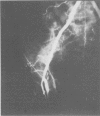Abstract
Retrospective analysis of the authors' experience with 109 primary femoropopliteal bypass vein grafts that failed allows description of three distinct modes of failure. Within 30 days of surgery, failure resulted primarily from technical or judgmental errors. The development of stenotic lesions within the vein graft caused a second group of failures during the first year after bypass. The third group most commonly failed due to progression of peripheral atherosclerosis a year or more following original bypass. No correlation was found, however, between the mode of failure and results of secondary femoropopliteal-tibial reconstruction, which yielded an overall 50% five-year cumulative limb salvage rate. The results indicate that this salvage rate can be anticipated regardless of the number of secondary operations required. The highest long-term patency rate was achieved when frequent postoperative follow-up examinations allowed recognition of graft failure prior to total occlusion. Under such circumstances a simple vein patch of stenotic lesions yielded an 85% five-year graft patency. Following actual thrombosis, however, the highest five-year patency rate was achieved when reconstruction was performed using a new vein graft; saphenous vein and arm vein were equally effective. When prosthetic material was used, no secondary graft remained patent beyond three years. Finally, when a proximal or distal portion of the original vein graft proved adequate in caliber following thrombectomy, it could be successfully incorporated in a secondary reconstruction with the expectation of a 50% five-year limb salvage rate. No statistically significant difference was found in salvage rates among each of the patient groups representing the three common modes of graft failure. This finding, coupled with an acceptable 2.5% operative mortality rate, provides justification for an aggressive approach toward secondary femoropopliteal reconstruction.
Full text
PDF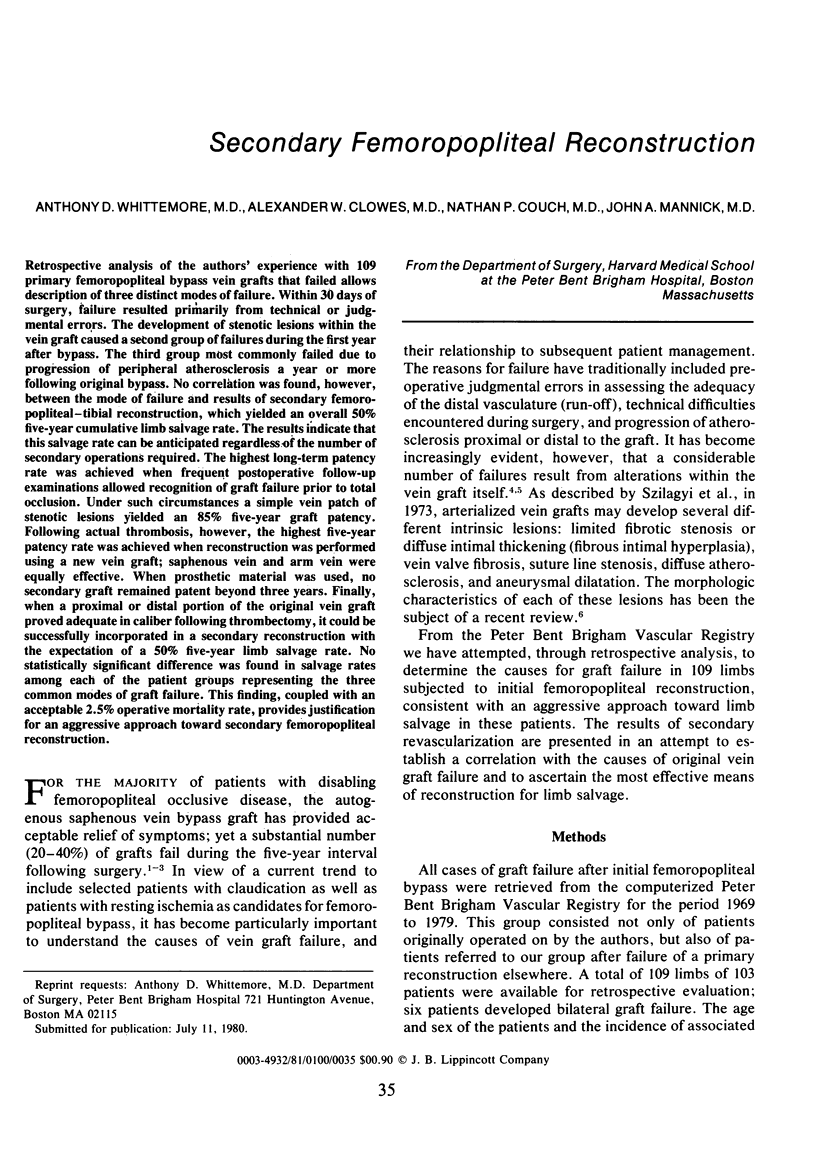
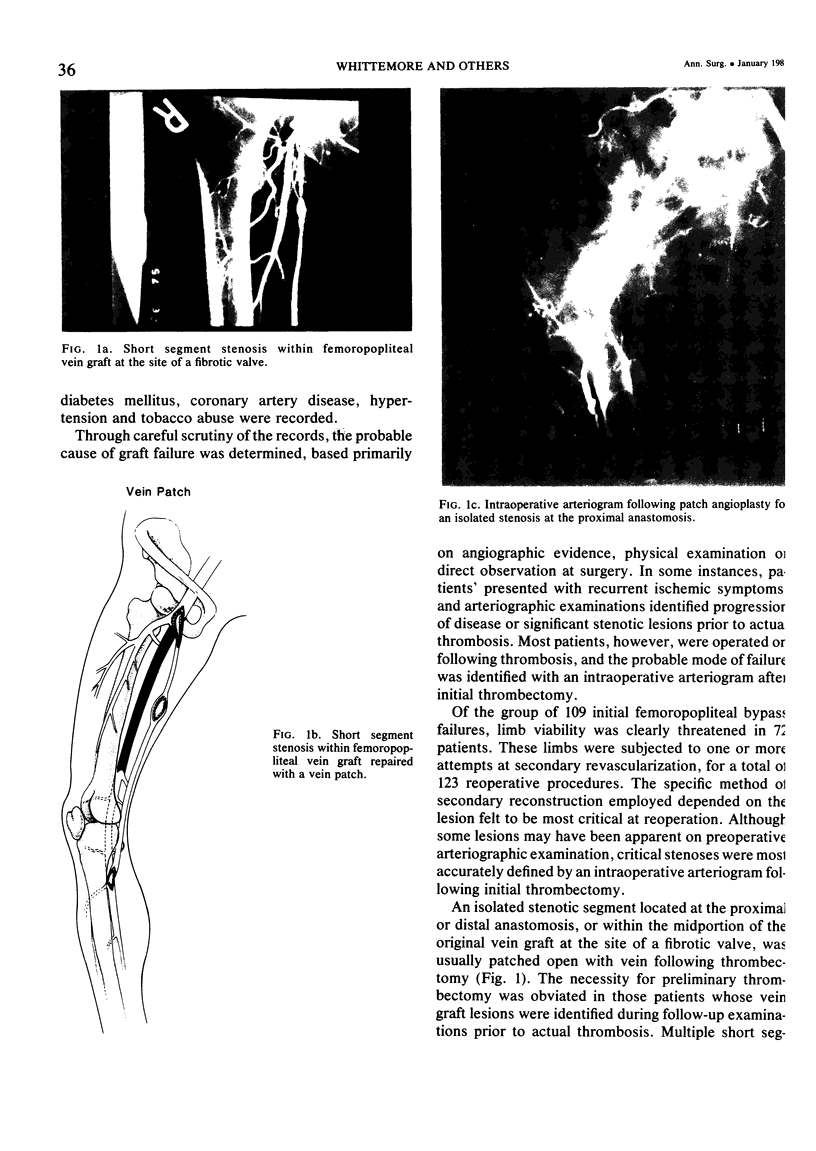
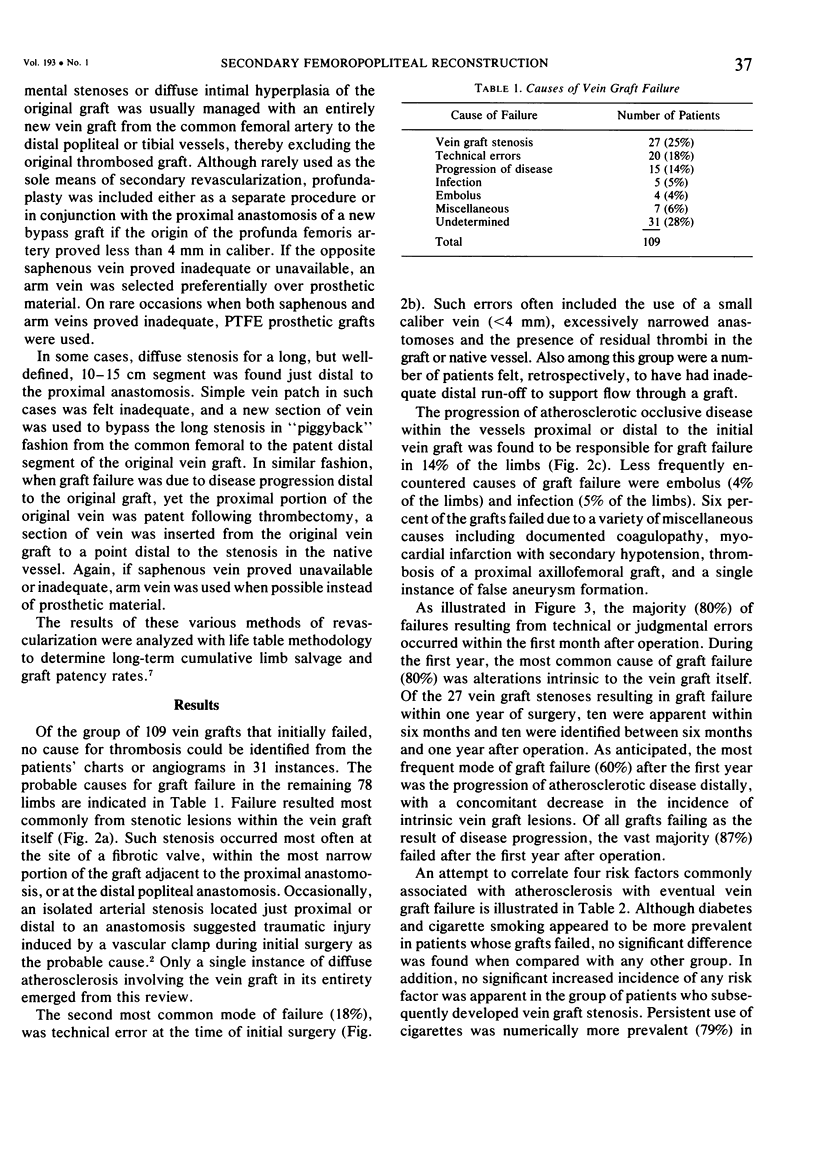
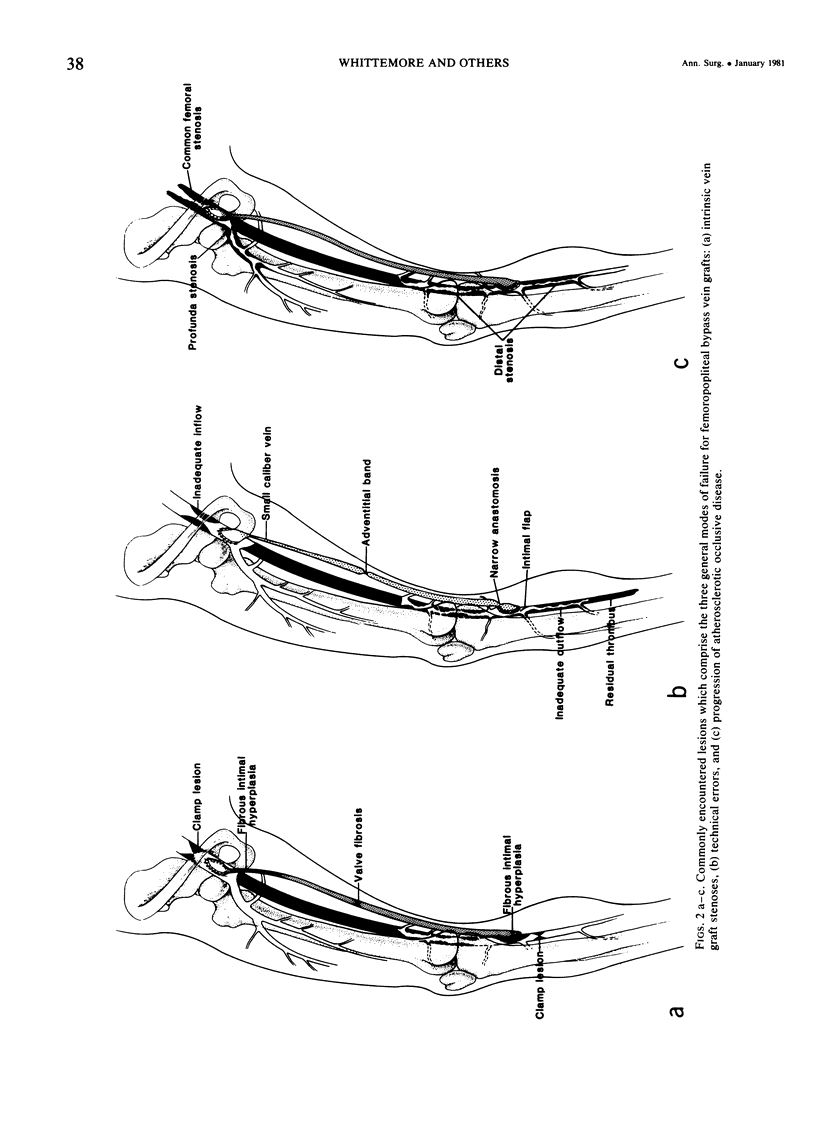

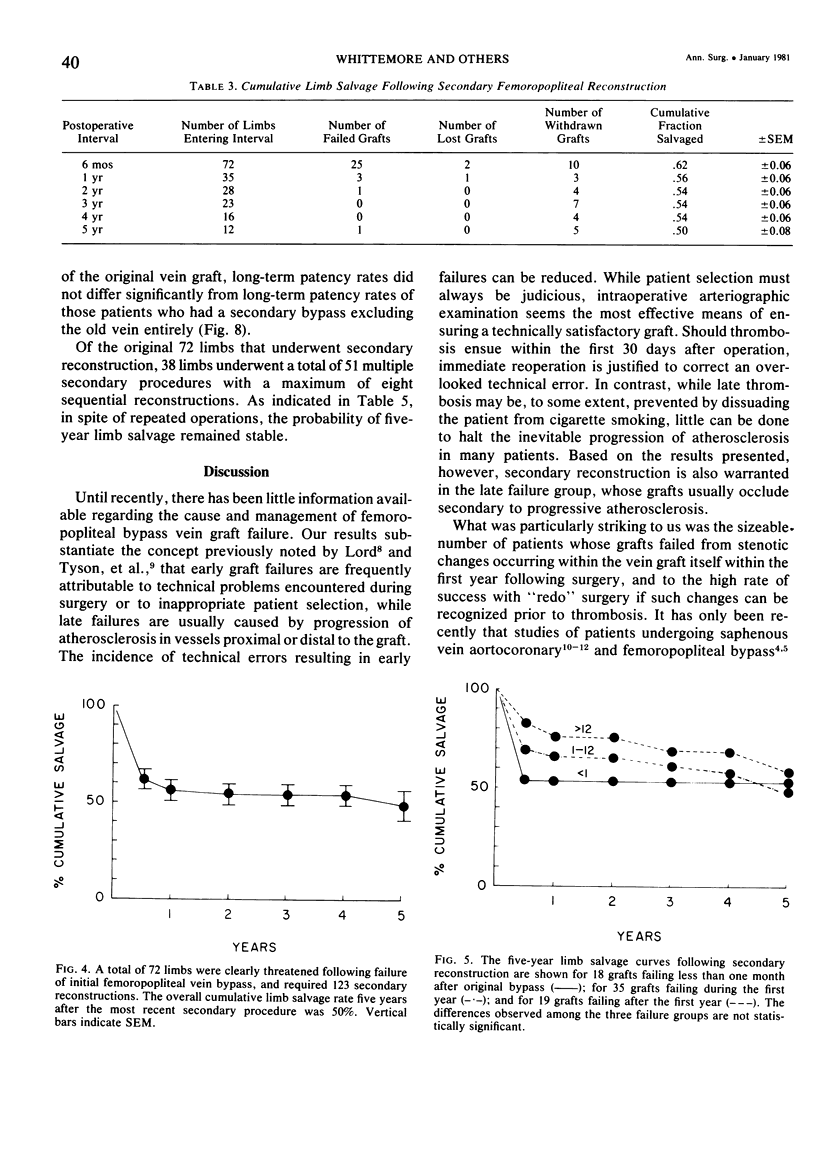
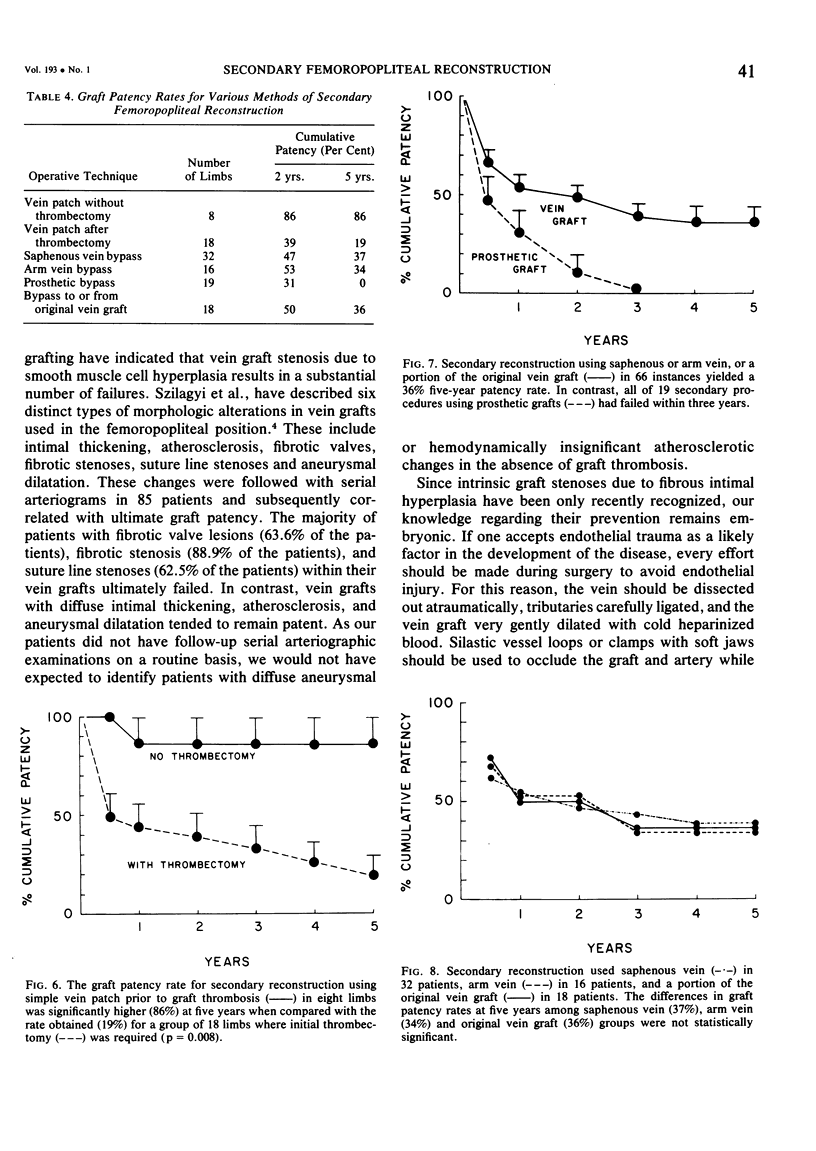
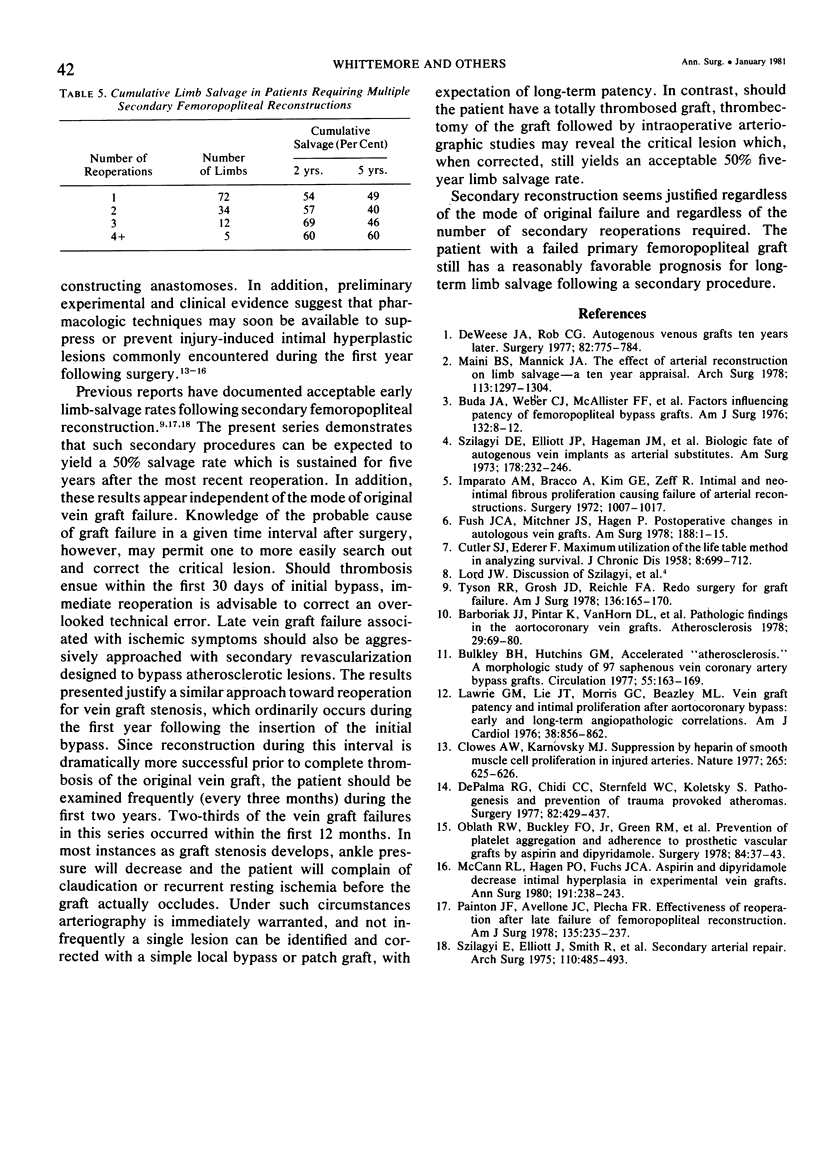
Images in this article
Selected References
These references are in PubMed. This may not be the complete list of references from this article.
- Barboriak J. J., Pintar K., Van Horn D. L., Batayias G. E., Korns M. E. Pathologic findings in the aortocoronary vein grafts. A scanning electron microscope study. Atherosclerosis. 1978 Jan;29(1):69–80. doi: 10.1016/0021-9150(78)90095-3. [DOI] [PubMed] [Google Scholar]
- Buda J. A., Weber C. J., McAllister F. F., Voorhees A. B., Jr Factors influencing patency of femoropopliteal artery bypass grafts. Am J Surg. 1976 Jul;132(1):8–12. doi: 10.1016/0002-9610(76)90279-8. [DOI] [PubMed] [Google Scholar]
- Bulkley B. H., Hutchins G. M. Accelerated "atherosclerosis". A morphologic study of 97 saphenous vein coronary artery bypass grafts. Circulation. 1977 Jan;55(1):163–169. doi: 10.1161/01.cir.55.1.163. [DOI] [PubMed] [Google Scholar]
- CUTLER S. J., EDERER F. Maximum utilization of the life table method in analyzing survival. J Chronic Dis. 1958 Dec;8(6):699–712. doi: 10.1016/0021-9681(58)90126-7. [DOI] [PubMed] [Google Scholar]
- Clowes A. W., Karnowsky M. J. Suppression by heparin of smooth muscle cell proliferation in injured arteries. Nature. 1977 Feb 17;265(5595):625–626. doi: 10.1038/265625a0. [DOI] [PubMed] [Google Scholar]
- DePalma R. G., Chidi C. C., Sternfeld W. C., Koletsky S. Pathogenesis and prevention of trauma-provoked atheromas. Surgery. 1977 Oct;82(4):429–437. [PubMed] [Google Scholar]
- DeWeese J. A., Rob C. G. Autogenous venous grafts ten years later. Surgery. 1977 Dec;82(6):755–784. [PubMed] [Google Scholar]
- Fuchs J. C., Mitchener J. S., 3rd, Hagen P. O. Postoperative changes in autologous vein grafts. Ann Surg. 1978 Jul;188(1):1–15. doi: 10.1097/00000658-197807000-00001. [DOI] [PMC free article] [PubMed] [Google Scholar]
- Imparato A. M., Bracco A., Kim G. E., Zeff R. Intimal and neointimal fibrous proliferation causing failure of arterial reconstructions. Surgery. 1972 Dec;72(6):1007–1017. [PubMed] [Google Scholar]
- Lawrie G. M., Lie J. T., Morris G. C., Jr, Beazley H. L. Vein graft patency and intimal proliferation after aortocoronary bypass: early and long-term angiopathologic correlations. Am J Cardiol. 1976 Dec;38(7):856–862. doi: 10.1016/0002-9149(76)90798-0. [DOI] [PubMed] [Google Scholar]
- Maini B. S., Mannick J. A. Effect of arterial reconstruction on limb salvage: a ten-year appraisal. Arch Surg. 1978 Nov;113(11):1297–1304. doi: 10.1001/archsurg.1978.01370230087010. [DOI] [PubMed] [Google Scholar]
- McCann R. L., Hagen P. O., Fuchs J. C. Aspirin and dipyridamole decrease intimal hyperplasia in experimental vein grafts. Ann Surg. 1980 Feb;191(2):238–243. doi: 10.1097/00000658-198002000-00018. [DOI] [PMC free article] [PubMed] [Google Scholar]
- Painton J. F., Avellone J. C., Plecha F. R. Effectiveness of reoperation after late failure of femoropopliteal reconstruction. Am J Surg. 1978 Feb;135(2):235–237. doi: 10.1016/0002-9610(78)90107-1. [DOI] [PubMed] [Google Scholar]
- Szilagyi D. E., Elliott J. P., Hageman J. H., Smith R. F., Dall'olmo C. A. Biologic fate of autogenous vein implants as arterial substitutes: clinical, angiographic and histopathologic observations in femoro-popliteal operations for atherosclerosis. Ann Surg. 1973 Sep;178(3):232–246. doi: 10.1097/00000658-197309000-00002. [DOI] [PMC free article] [PubMed] [Google Scholar]
- Szilagyi D. E., Elliott J. P., Smith R. F., Hageman J. H., Sood R. K. Secondary arterial repair. The management of late failures in reconstructive arterial surgery. Arch Surg. 1975 May;110(5):485–493. doi: 10.1001/archsurg.1975.01360110031007. [DOI] [PubMed] [Google Scholar]
- Tyson R. R., Grosh J. D., Reichle F. A. Redo surgery for graft failure. Am J Surg. 1978 Aug;136(2):165–170. doi: 10.1016/0002-9610(78)90219-2. [DOI] [PubMed] [Google Scholar]




